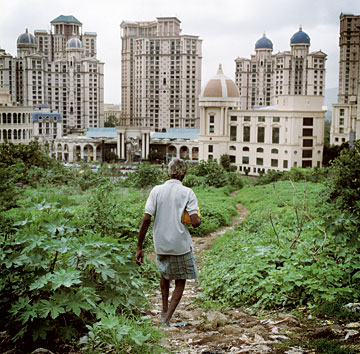
Divided land: In Mumbai, India's boom has widened the gap between rich and poor
(3 of 3)
Indeed, while India reduced its poverty rate during its recent boom years, the absolute number of desperately poor Indians increased from 436 million in 1990 to 456 million in 2005, or 42% of the population. Some development experts in India say that's because leaders haven't directed enough resources to the countryside, home to 70% of Indians. "India's growth is not sustainable without improving food production," says Arup Mitra, an economist at the Institute of Economic Growth in the University of Delhi. "But so far, little action has taken place." Critics of India's economic policy say exports and foreign investment have brought benefits mainly to a small number of city dwellers, while India's new wealth hasn't been employed to build roads, irrigation systems and schools for the hinterlands. "Growth has failed to lift the quality of life in villages and small towns," says Ajay Mehta, executive director of the nonprofit National Foundation for India. Much of India remains almost completely untouched by the years of near double-digit growth. In the village of Dhala in the hills of Rajasthan, Suresh Bhagora grows maize and black-eyed peas and resides in a two-room hut much like his forebears did, ignorant of the dramatic economic progress taking place elsewhere in the country. "If [policymakers] are doing anything," he says, "I haven't heard about it."
That attitude is sadly common. An export-at-all-costs mentality has led officials to ignore potential sources of growth in their own backyards. With feeble social safety nets to protect them, many families in emerging nations tend to save for a rainy day rather than splurge with their new wealth. And when consumers in the U.S. and Europe scale back in times of recession — as they are doing now — export-dependent developing countries can't count on domestic demand to soften the blow. The Chinese leadership, for its part, has awakened to this danger and is furiously striving to stimulate domestic demand, hoping to bring more balance to its economy. Beijing is also strengthening property rights for farmers to boost welfare in the still poor countryside and improving the health-care system. "There is certainly a need to realize that you cannot rely entirely on an export-led growth model," says Jim Walker, an economist at independent research firm Asianomics in Hong Kong. "There has to be some encouragement of the domestic economy."
Think Global, Act Local
Much more needs to be done. as competition for export markets and foreign investment intensifies, governments need to develop better education programs that can churn out qualified workers, build efficient ports and airports to smooth trade, and introduce business-friendly tax and regulatory policies. Indonesia's antipoverty efforts have stalled recently due to restrictive labor laws and other measures that have scared away job-creating investment. India lacks the infrastructure and basic education system to attract the kind of mass-scale, labor-intensive manufacturing that could lure farmers from the countryside and create a China-like boom in low-skilled jobs.
All that said, most economists believe poor countries would make a dire error if they were to reject globalization altogether. "The export model may come under scrutiny, but it is still the right model to get people out of poverty," says Danny Leipziger, vice president for poverty reduction at the World Bank in Washington. And despite the trials of the current crisis, policymakers in developing countries have so far shown little inclination to withdraw from the world. In Vietnam, where the export sector has been battered by the downturn, leaders "are beyond such wild ideas," says Adam McCarty, chief economist with Mekong Economics, a research firm in Hanoi. McCarty says the alternative is to look inward and become a version of North Korea. The Hermit Kingdom, he says, "is certainly not suffering the negative effects of recent events." But the country has "missed out on decades of globalization-driven growth."
Narayan Dangi, 42, doesn't want to miss out. He was a laborer for a state-owned zinc smelter in the central Indian district of Udaipur — a poor region, albeit famous for the glistening white palaces of the local maharaja — when India's market reforms rescued him. In 2002, a private company, now a subsidiary of U.K.-based Vedanta Resources, began acquiring stakes in the zinc company, and it today owns 65%. The new owner invested to increase capacity and began exporting for the first time. Dangi's salary nearly tripled, to about $6 a day. He purchased a motorcycle and rebuilt his home. His standard of living has improved more since the new investor's arrival, he says, than in the previous 16 years. "Money has been rolling in," he says. "One man getting a job here benefits 25." We may be living through a painful downturn. But joining the global economy remains the best hope for the world's poor.
— with reporting by Zamira Loebis/Jakarta, Martha Ann Overland/Hanoi and Madhur Singh/Udaipur